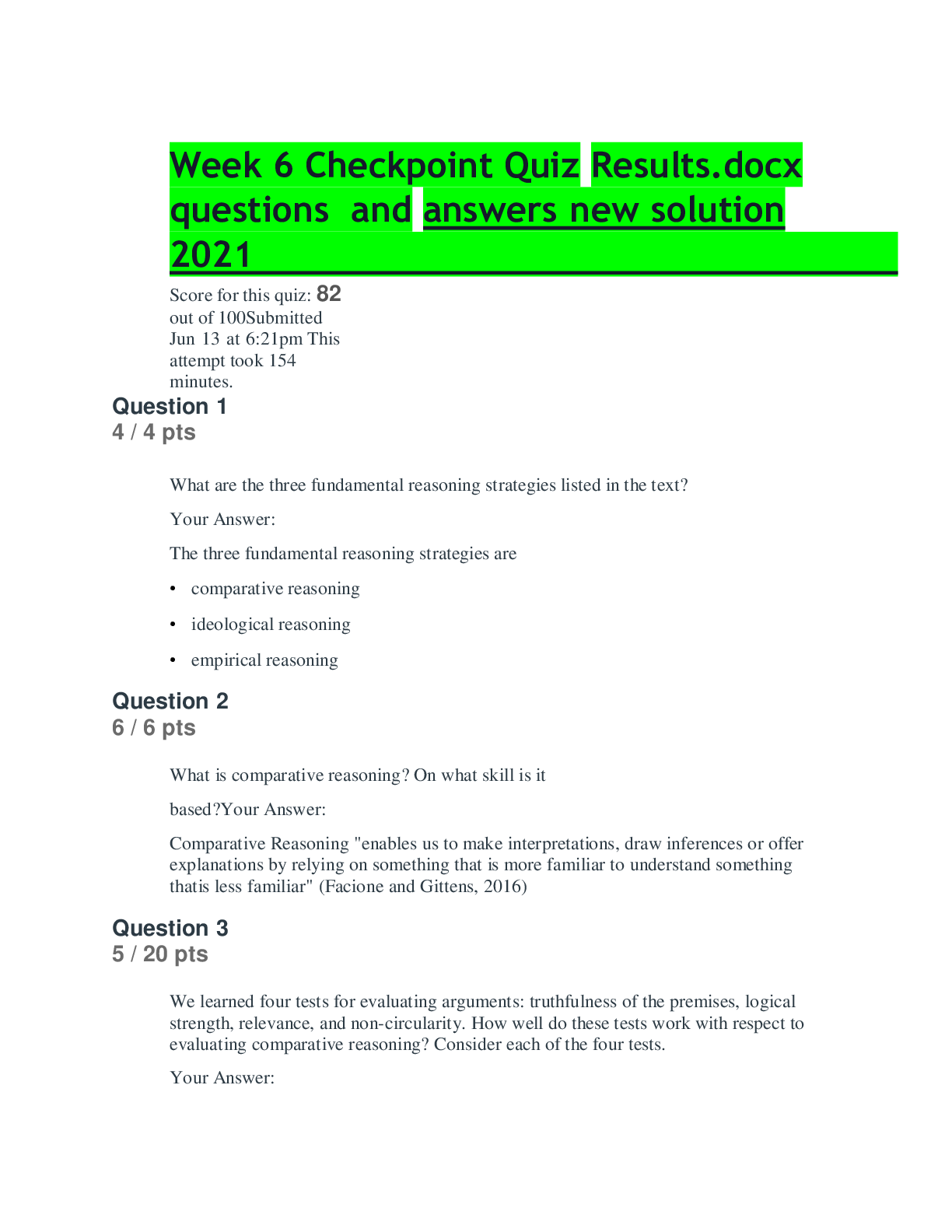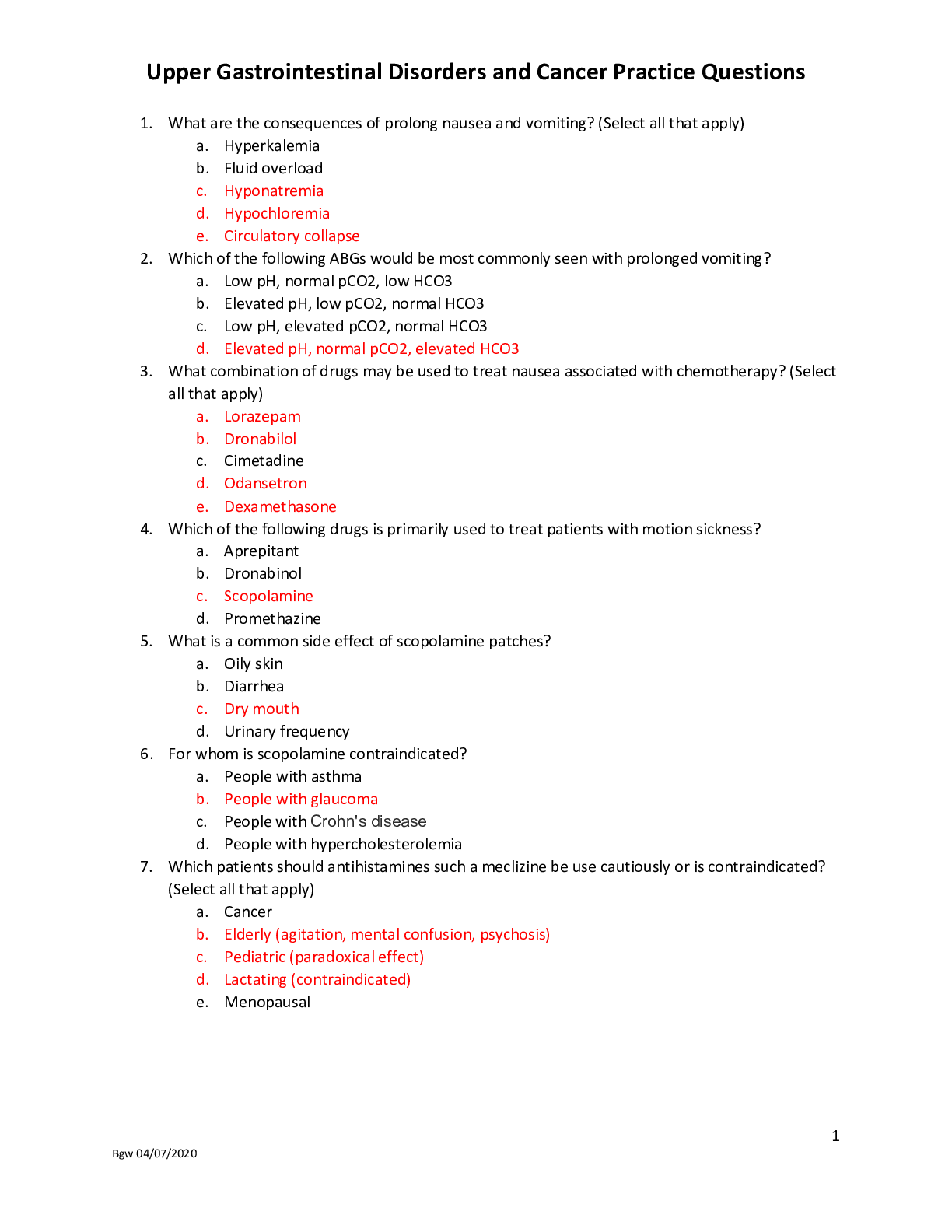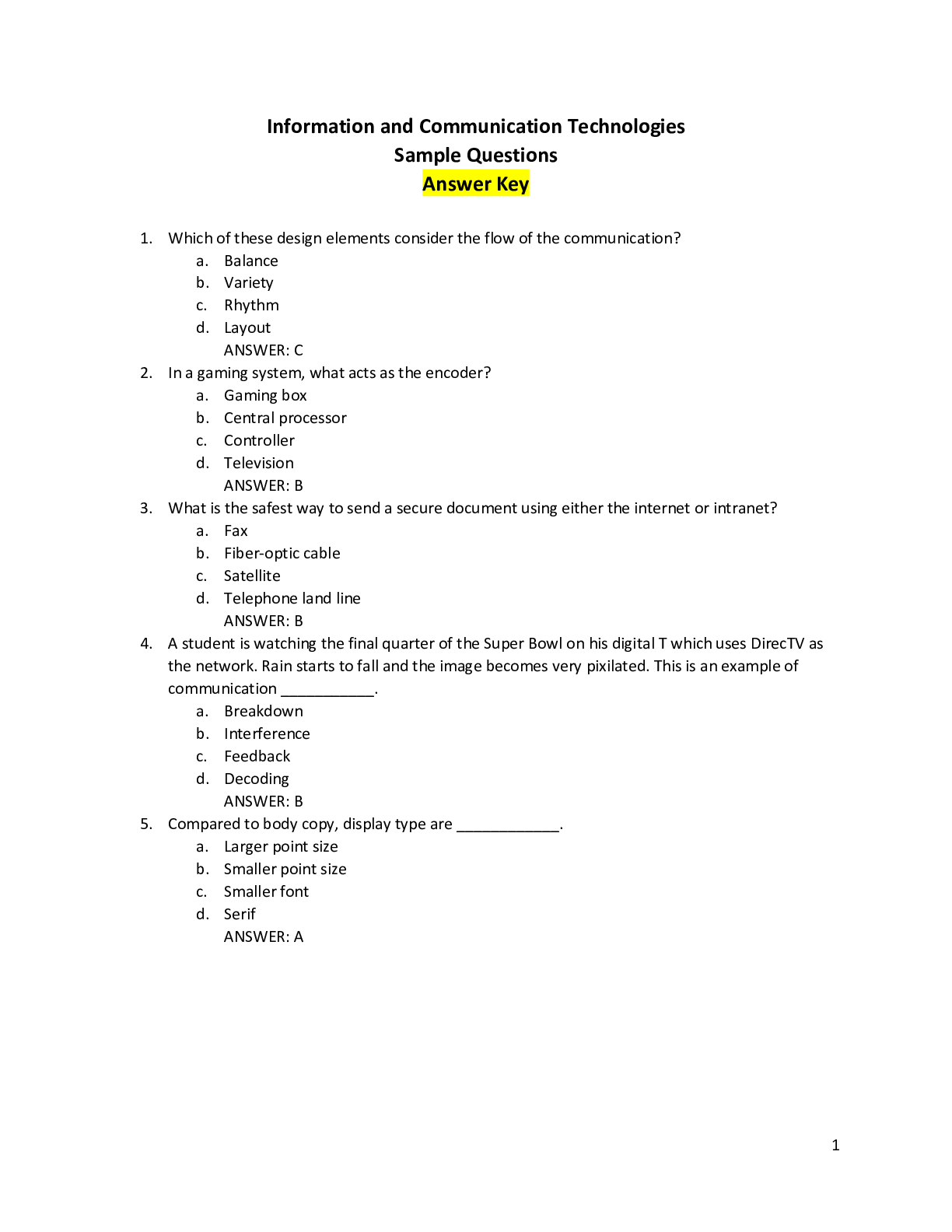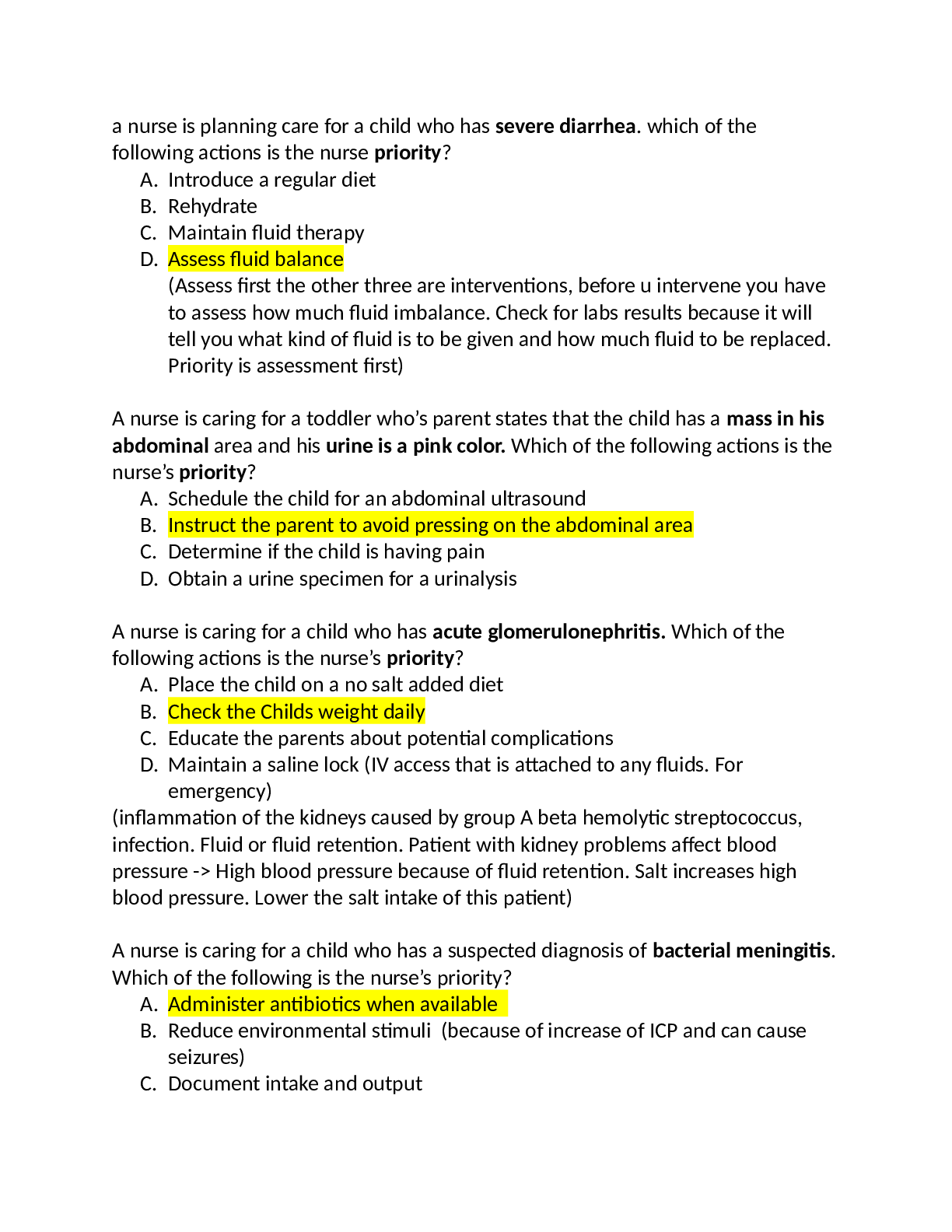Environmental Science > QUESTIONS & ANSWERS > APES Unit 2: Living World, Questions and answers, 100% Accurate. Rated A+ (All)
APES Unit 2: Living World, Questions and answers, 100% Accurate. Rated A+
Document Content and Description Below
APES Unit 2: Living World, Questions and answers, 100% Accurate. Rated A+ Ecology - ✔✔-Study of the interactions between living things and their environment. Population - ✔✔-A group of the... same species in the same area. Community - ✔✔-Different species in the same area. Ecosystem - ✔✔-All members of a community and the nonliving things they interact with in the same area. Biosphere - ✔✔-Sum of all the ecosystems on earth (includes part of the atmosphere, hydrosphere, and lithosphere). Abiotic Factors - ✔✔-The nonliving components of an ecosystem. Limiting Factors - ✔✔-Controls population growth. Biotic Factors - ✔✔-Living components of an ecosystem. Ecological Niche - ✔✔-A species' functional role in its ecosystem. Competitive Exclusion Principle - ✔✔-Two species cannot occupy the same niche indefinitely. Resource Partitioning - ✔✔-The use of the same resource by different species, but in different times, ways, or places. Fundamental Niche - ✔✔-If no competitors are present, a species will occupy this. Realized Niche - ✔✔-The role a species plays in an ecosystem in reality, with competitors present. Generalist - ✔✔-A species that has a broad niche and is successful in changing environments. Ex. Mountain Lion, Rats, Raccoons Specialist - ✔✔-A species with a narrow niche and is successful in a stable environment. Ex. Northern Spotted Owl, Giant Pands Interspecific Competition - ✔✔-When two species both require the same resource. Intraspecific Competition - ✔✔-When there are conflicts over resources within the same species. Symbiosis - ✔✔-The close, intimate relationship between two species. Parasitism - ✔✔-A type of symbiosis where one species, usually the smaller species, benefits from a host, while the host is weakened (but rarely killed). Mutualism - ✔✔-Symbiosis where both species benefit. Ex. clownfish and sea anemone. Commensalism - ✔✔-Symbiosis where one species benefits and the other is unaffected. Ex. sharks and remora. Predation - ✔✔-Where one animal feeds on another. Keystone Species - ✔✔-An organism that plays an integral role in the ecosystem insofar that they effectively control the ecosystem. Relative Species Abundance - ✔✔-Determines biodiversity, expressed as a percent. How many of an organism compared to other organisms. Low in areas of high diversity. Species Richness - ✔✔-Determines biodiversity, number of different organisms. High where biodiversity is high. Tropical Rainforest - ✔✔-Highest terrestrial biodiversity (due to parasites and diseases). Coral Reef - ✔✔-Highest aquatic biodiversity. Edge Effect - ✔✔-When the barrier between two ecosystems has different abiotic factors that are different from either ecosystem. Biome - ✔✔-Large region with a distinct climate and vegetation. Temperate/Deciduous Forest - ✔✔-Country with most of this biome: USA Seasonal, drops leaves in fall. Leaf litter, rich soil layer, adopted to fire. Taiga/Boreal Forest - ✔✔-Country with most of this biome: Russia 60 degrees north, low plant diversity, cold, slow decomposition, acidic soil, waxy needles difficult to break down, coniferous trees. Tropical Rainforest - ✔✔-Country with most of this biome: Brazil Stable, unchanging climate. Daily, heavy rains. Understory is dark; fast decomposition rates. Soil nutrients are low, most contained in biomass. Desert - ✔✔-Country with most of this biome: Saudi Arabia/Australia Evaporation rate exceeds precipitation rate, 30 degrees north and south. Interior of a large continent, rain shadows. Grassland - ✔✔-Biome with erratic precipitation, dominated by grazers, maintained by fire. Chapparal - ✔✔-Biome with a costal climate. Mild, rainy winters, warm, dry summers. Fire most common in fall (shrubs). Tundra - ✔✔-Biome that is cold, windy, dry. Mosses, grasses, dwarf shrubs. Permafrost, melting causes wotterlogging. Animals have thick fur, fat, huddling. Slow plant growth and decomposition. Photic Zone - ✔✔-The area of the ocean that gets light. CO2 is low, O2 is high. Phytoplankton, cyanobacteria, plants, algae. Aphotic Zone - ✔✔-The area of the ocean with no light. Low O2, High CO2. Decomposition, consumers. Neritic Zone - ✔✔-The area of the ocean above the continental shelf. Warm, abundant light. Dissolved oxygen high. High nutrient levels, productive ecosystem. Coastal Estuaries/Wetlands - ✔✔-Where the river flows into an ocean. A delta usually develops; is the ecotone between freshwater and the ocean. Filter water, buffer zone for storms and hurricanes. Intertidal Zone - ✔✔-Organisms in this ocean zone have to deal with drastic, daily changes. Barrier Islands - ✔✔-Build up slowly over time as waves lap land and leave sand. Erosion caused by destructive waves, protect coastlines from wave actions. Coral Reefs - ✔✔-Extremely diverse, organisms are either attached, fish, or species that bore or hide. Oceanic Zone - ✔✔-Includes euphotic zone, bathyal zone, and abyssal zone. Euphotic Zone - ✔✔-Area of the open ocean that gets a lot of light. Low in nutrients, too far from coast. High dissolved oxygen, phytoplankton. Most large fish live here. Bathyal Zone - ✔✔-Area of the ocean that is dimly lit, with no producers. Dominated by zooplankton and small fish. Abyssal Zone - ✔✔-Area of the ocean with no photosynthetic organisms. Chemosynthetic bacteria can be found here. Low in dissolved oxygen, high in nutrients. Deposit feeders and filter feeders. Lentic Zone - ✔✔-Standing water. Littoral Zone - ✔✔-Found throughout a pond, or the edge of a lake. Have plants rooted to bottom and emerging from water or floating. Shallow, lit throughout. Limnetic Zone - ✔✔-Area of a lake; open, sunlit waters away from shore and dominated by phytoplankton. High dissolved oxygen. Profundal Zone - ✔✔-Area of a lake; deep water, too dark for photosynthesis. Low oxygen. Benthic Zone - ✔✔-Lines the bottom of a lake, low in oxygen, high in sediment. Dominated by decomposers and detritus feeders. Oligotrophic - ✔✔-A kind of lake; clear, rocky, gravelly, found in mountains. Low in nutrients and life. Mesotrophic - ✔✔-A kind of lake; Neither cloudy or clear, most lakes are of this type. Some floating plants. Eutrophic - ✔✔-A kind of lake. A lot of sediment, algae. Turbid, shallow, murky. High in nutrients, vegetation, plankton, life, fish. Lotic Zone - ✔✔-Moving water. Riparian Zone - ✔✔-River banks, most vulnerable part of the lotic zone, susceptible to erosion. Must be well covered in vegetation to avoid erosion. Watershed - ✔✔-A land area that delivers runoff, sediment, and dissolved substances to a stream, river, or ocean. Source Zone - ✔✔-Waterfalls and rapids; clear, cold water. Fast-moving, high turbulence, increases dissolved oxygen. Trout and salmon. Transition Zone - ✔✔-Water moving to lower levels of a mountain. Stream widens and deepens, gentler slope, slower moving. Warm water, plankton and fish. Floodplain Zone - ✔✔-Now a river; wide, deep. Flows across flat valley, usually between hills and mountains. Water occasionally dumps nutrients onto land. Inland Wetlands - ✔✔-Areas that are covered in water at least prat of the time with the exception of rivers, lakes, and streams. Very productive. With trees = swamp. Without = marsh. Biodiversity - ✔✔-Influenced by species richness and species abundance. Ecosystem Services - ✔✔-Natural processes that benefit humans. Ex. bats eat mosquitoes, green plants absorb CO2 and release O2. Evolution - ✔✔-Change in a population's genetic makeup over time. Microevolution - ✔✔-Small genetic changes in the gene frequencies of a population. Gene Flow - ✔✔-The transfer of alleles or genes from one population to another. Ex. immigration, emigration. Genetic Drift - ✔✔-Random shifts in allele frequencies. Mutations - ✔✔-Random appearance of a new trait due to changes in DNA, caused by mistakes in copying DNA or exposure to ionizing radiation. Natural Selection - ✔✔-When the species that are able to survive longer reproduce more and then pass their genes onto their offspring. Macroevolution - ✔✔-Large-scale changes in the b [Show More]
Last updated: 2 years ago
Preview 1 out of 11 pages
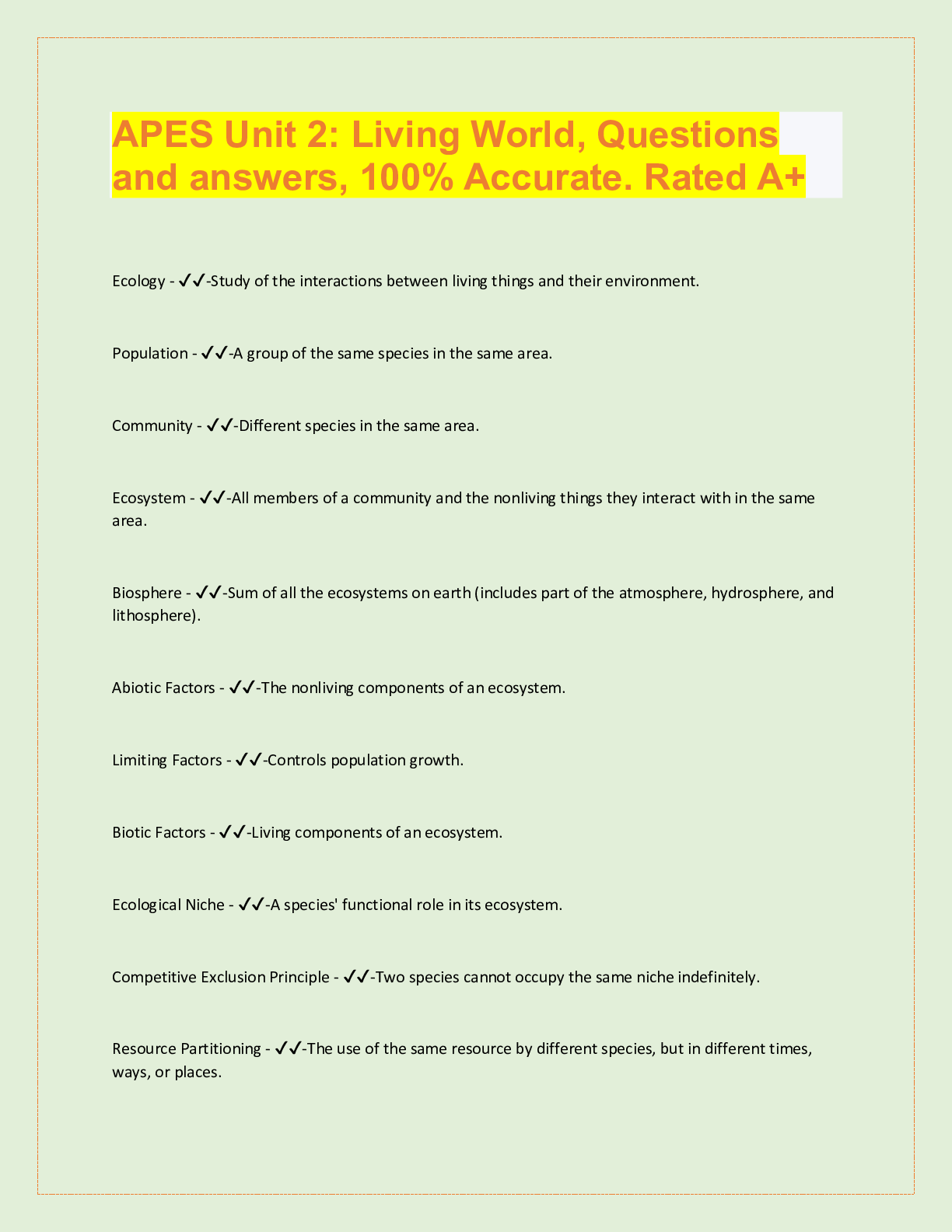
Buy this document to get the full access instantly
Instant Download Access after purchase
Buy NowInstant download
We Accept:

Also available in bundle (1)

APES, Exam Bundle, Questions and answers, VERIFIED. 23 VERSIONS
AP Environmental Science Exam Review Exam prep questions sections coverage, rated A+ APES, Exam Questions and answers, 100% Accurate. Graded A+. 23 different versions
By Topmark 2 years ago
$45
21
Reviews( 0 )
$9.00
Can't find what you want? Try our AI powered Search
Document information
Connected school, study & course
About the document
Uploaded On
Mar 12, 2023
Number of pages
11
Written in
Additional information
This document has been written for:
Uploaded
Mar 12, 2023
Downloads
0
Views
130

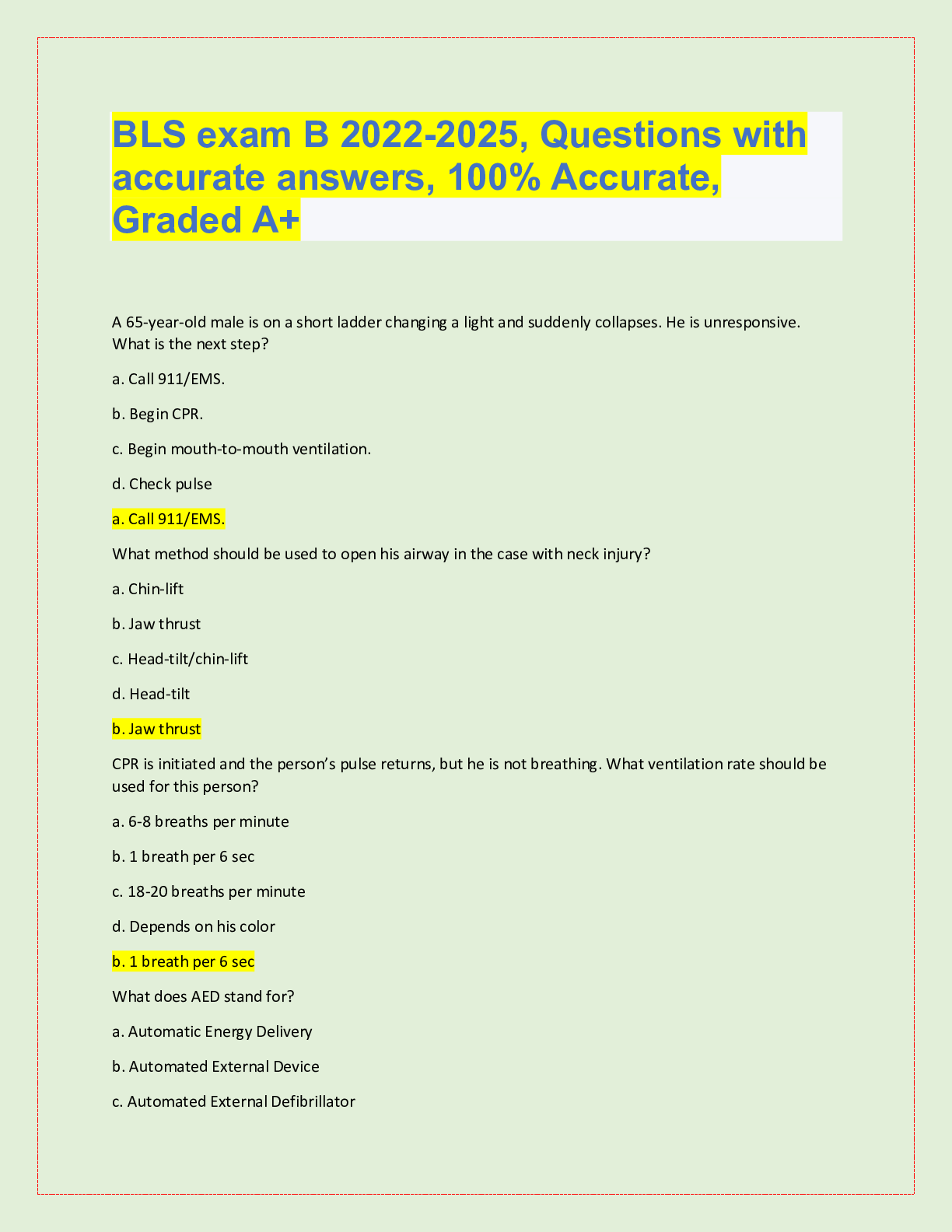











.png)




